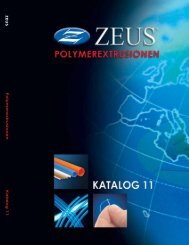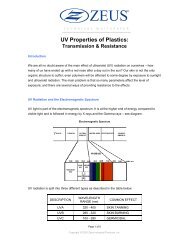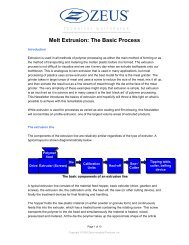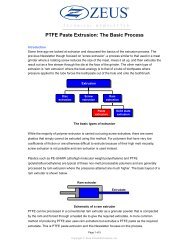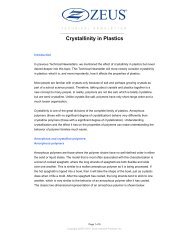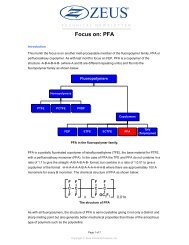Focus on: FEP - Zeus Industrial Products, Inc.
Focus on: FEP - Zeus Industrial Products, Inc.
Focus on: FEP - Zeus Industrial Products, Inc.
You also want an ePaper? Increase the reach of your titles
YUMPU automatically turns print PDFs into web optimized ePapers that Google loves.
<strong>FEP</strong> was first produced by DuP<strong>on</strong>t in 1956 as Tefl<strong>on</strong> � <strong>FEP</strong> and was the first commercially<br />
produced material to combine the unique mechanical and chemical properties of the<br />
fluoropolymers with the melt-processability of more c<strong>on</strong>venti<strong>on</strong>al polymers. Inevitably, the search<br />
for melt-processability required some minor trade-offs in mechanical and physical properties, and<br />
while <strong>FEP</strong> is superior to PTFE in some properties (i.e. impact strength), the general mechanical<br />
and chemical properties of <strong>FEP</strong> are very similar to those of PTFE. The major difference is that the<br />
maximum service temperature for <strong>FEP</strong> is 205 o C and this is about 60 o C lower than that of PTFE.<br />
Properties<br />
The general properties of <strong>FEP</strong> are typical of other semi-crystalline high performance<br />
thermoplastics:<br />
� Very good temperature stability<br />
� Outstanding electrical properties<br />
� Outstanding chemical resistance<br />
� Outstanding weathering resistance<br />
� Low coefficient of fricti<strong>on</strong><br />
� Excellent toughness but generally low mechanical strength<br />
� High cost<br />
Physical and Mechanical<br />
The physical and mechanical properties of <strong>FEP</strong> are broadly comparable to those of PTFE.<br />
However, the temperature of use is restricted to a smaller range (-240°C to +205°C) and some<br />
mechanical properties (such as cut through and abrasi<strong>on</strong> resistance) are less than PTFE.<br />
Typical mechanical and thermal properties are given in the table below.<br />
Property<br />
Page 2 of 6<br />
Approximate Value<br />
Natural polymer<br />
Tensile Strength (@23 o C) 14 – 20 MPa<br />
Tensile Modulus (@ 1% strain @ 23 o C) 0.6 GPa<br />
El<strong>on</strong>gati<strong>on</strong> at Break (@23 o C) 300%<br />
Flexural Strength (@23 o C) No Break<br />
Izod Notched Impact Strength (@23 o C) No Break<br />
Coefficient of fricti<strong>on</strong> (dynamic) 0.25<br />
Heat Deflecti<strong>on</strong> Temperature (0.45 MPa) 60 o C<br />
Low Temperature Toughness –240 o C<br />
Coefficient of Thermal Expansi<strong>on</strong> (20 – 100 o C) 5 x 10 -5 / o C<br />
Copyright © <strong>Zeus</strong> <strong>Industrial</strong> <strong>Products</strong>, <strong>Inc</strong>.



